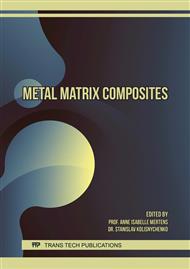[1]
Schöbel M, Altendorfer W, Degischer HP, Vaucher S, Buslaps T, Michiel MD, et al. Internal stresses and voids in SiC particle reinforced aluminum composites for heat sink applications. Composites Science and Technology. 2011;71(5):724-33.
DOI: 10.1016/j.compscitech.2011.01.020
Google Scholar
[2]
Schöbel M, Degischer HP, Vaucher S, Hofmann M, Cloetens P. Reinforcement architectures and thermal fatigue in diamond particle-reinforced aluminum. Acta Materialia. 2010;58(19):6421-30.
DOI: 10.1016/j.actamat.2010.08.004
Google Scholar
[3]
Kouzeli M, Weber L, San Marchi C, Mortensen A. Quantification of microdamage phenomena during tensile straining of high volume fraction particle reinforced aluminium. Acta Materialia. 2001;49(3):497-505.
DOI: 10.1016/s1359-6454(00)00334-7
Google Scholar
[4]
Monje IE, Louis E, Molina JM. Optimizing thermal conductivity in gas-pressure infiltrated aluminum/diamond composites by precise processing control. Composites Part A: Applied Science and Manufacturing. 2013;48(0):9-14.
DOI: 10.1016/j.compositesa.2012.12.010
Google Scholar
[5]
Edtmaier C, Segl J, Rosenberg E, Liedl G, Pospichal R, Steiger-Thirsfeld A. Microstructural characterization and quantitative analysis of the interfacial carbides in Al(Si)/diamond composites. Journal of Materials Science. 2018;53(22):15514-29.
DOI: 10.1007/s10853-018-2734-1
Google Scholar
[6]
Ruch PW, Beffort O, Kleiner S, Weber L, Uggowitzer PJ. Selective interfacial bonding in Al(Si)–diamond composites and its effect on thermal conductivity. Composites Science and Technology. 2006;66(15):2677-85.
DOI: 10.1016/j.compscitech.2006.03.016
Google Scholar
[7]
Monachon C, Weber L. Influence of diamond surface termination on thermal boundary conductance between Al and diamond. Journal of Applied Physics. 2013;113(18):183504.
DOI: 10.1063/1.4804061
Google Scholar
[8]
Edtmaier C, Bauer E, Weber L, Tako ZS, Segl J, Friedbacher G. Temperature dependence of the thermal boundary conductance in Ag–3Si/diamond composites. Diamond and Related Materials. 2015;57:37-42.
DOI: 10.1016/j.diamond.2015.01.010
Google Scholar
[9]
Edtmaier C, Bauer E, Segl J, Foelske-Schmitz A, Pambaguian L. Thermophysical behavior of diamond composites for diode laser heat sink applications at temperatures between 4 K and ambient. 46th International Conference on Environmental Systems. Vienna: Texas Tech University Library; 2016. pp.1-14.
Google Scholar
[10]
Hutsch T, Schubert T, Weißgärber T, Kieback B. Thermal conductivity of PM Cu/diamond composites depending on the chromium content-prediction and characterization. World PM 2016 Congress and Exhibition2016.
Google Scholar
[11]
Schubert T, Trindade B, Weißgärber T, Kieback B. Interfacial design of Cu-based composites prepared by powder metallurgy for heat sink applications. Materials Science and Engineering: A. 2008;475(1–2):39-44.
DOI: 10.1016/j.msea.2006.12.146
Google Scholar
[12]
Hutsch T, Schubert T, Weißgärber T, Kieback B. Silver/diamond composite material - Powder metallurgical route and thermo-physical properties. Key Engineering Materials2017. pp.151-7.
DOI: 10.4028/www.scientific.net/kem.742.151
Google Scholar
[13]
Beffort O, Khalid FA, Weber L, Ruch P, Klotz UE, Meier S, et al. Interface formation in infiltrated Al(Si)/diamond composites. Diamond and Related Materials. 2006;15(9):1250-60.
DOI: 10.1016/j.diamond.2005.09.036
Google Scholar
[14]
Chen G, Yang W, Xin L, Wang P, Liu S, Qiao J, et al. Mechanical properties of Al matrix composite reinforced with diamond particles with W coatings prepared by the magnetron sputtering method. Journal of Alloys and Compounds. 2018;735:777-86.
DOI: 10.1016/j.jallcom.2017.11.183
Google Scholar
[15]
Hofmann M, Schneider R, Seidl GA, Rebelo-Kornmeier J, Wimpory RC, Garbe U, et al. The new materials science diffractometer STRESS-SPEC at FRM-II. Physica B: Condensed Matter. 2006;385-386:1035-7.
DOI: 10.1016/j.physb.2006.05.331
Google Scholar
[16]
Zeitelhack K, Schanzer C, Kastenmüller A, Röhrmoser A, Daniel C, Franke J, et al. Measurement of neutron flux and beam divergence at the cold neutron guide system of the new Munich research reactor FRM-II. Nuclear Instruments and Methods in Physics Research Section A: Accelerators, Spectrometers, Detectors and Associated Equipment. 2006;560(2):444-53.
DOI: 10.1016/j.nima.2005.12.215
Google Scholar
[17]
Hoelzel M, Gan WM, Hofmann M, Randau C, Seidl G, Jüttner P, et al. Rotatable multifunctional load frames for neutron diffractometers at FRM II—design, specifications and applications. Nuclear Instruments and Methods in Physics Research Section A: Accelerators, Spectrometers, Detectors and Associated Equipment. 2013;711:101-5.
DOI: 10.1016/j.nima.2013.01.049
Google Scholar
[18]
Rebelo-Kornmeier J, Hofmann M, Gan WM, Randau C, Braun K, Zeitelhack K, et al. New Developments of the Materials Science Diffractometer STRESS-SPEC. Materials Science Forum. 2017;905:151-6.
DOI: 10.4028/www.scientific.net/msf.905.151
Google Scholar
[19]
Randau C, Garbe U, Brokmeier H-G. StressTextureCalculator: a software tool to extract texture, strain and microstructure information from area-detector measurements. Journal of Applied Crystallography. 2011;44(3):641-6.
DOI: 10.1107/s0021889811012064
Google Scholar
[20]
Rebelo Kornmeier J, Gibmeier J, Hofmann M. Minimization of spurious strains by using a Si bent-perfect-crystal monochromator: neutron surface strain scanning of a shot-peened sample. Measurement Science and Technology. 2011;22(6):065705.
DOI: 10.1088/0957-0233/22/6/065705
Google Scholar



